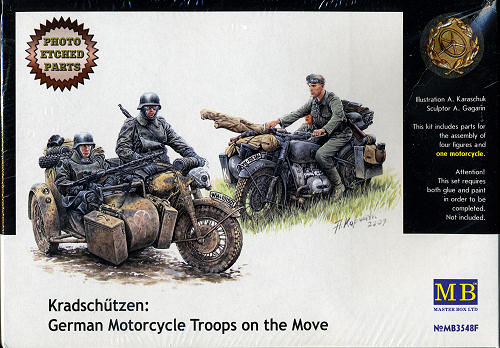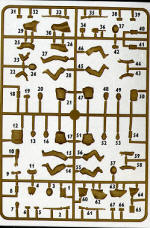
MasterBox 1/35 German Motorcycle Troops on the Move
| KIT #: | MB3548F |
| PRICE: | $47.50 MSRP |
| DECALS: | Several options |
| REVIEWER: | Scott Van Aken |
| NOTES: | Includes Photo Etch Fret |

| HISTORY |
The BMW R75 was World War II-era motorcycle and sidecar combination produced by the German company BMW.
BMW were already producing a number of popular and highly effective motorcycles, and developed the R75 in response to a request from the German army to make a machine more capable in off-road conditions, the Zündapp KS 750. BMW copied the technically advanced Zündapp KS 750 in which the third side-car wheel was driven from an axle connected to the rear wheel of the motorcycle, effectively making it a three-wheeled vehicle. Fitted with a locking differential and selectable road and off-road gear ratios the R75 was highly manoeuvrable and capable of negotiating most surfaces. It was even fitted with a reverse gear.
The BMW R75 and its rival the Zündapp KS 750 were both widely used by the Wehrmacht in Russia and North Africa, though after a period of evaluation it became clear that the Zündapp was the superior machine. In August 1942Zündapp and BMW, on the urging of the Army, agreed upon standardization of parts for both machines, with a view of eventually creating a Zündapp-BMW hybrid, in which a 286/1 side-car would be grafted onto a Zündapp KS 750 motorcycle. They also agreed that the manufacture of the R75 would cease once production reached 20,200 units, and after that point BMW and Zündapp would only produce the Zündapp-BMW machine, manufacturing 20,000 each year.
Since the target of 20,200 BMW R75's was not reached, it remained in production until the Eisenach factory was so badly damaged by Allied bombing that production ceased in 1944. A further 98 units were assembled by the Soviets in 1946 as reparations.
However the standardisation programme meant that machines that were produced by BMW and Zündapp used 70% of the same components. This simplifies the supply of spare parts for these vehicles, many of which are still in the hands of historic motorcycle enthusiasts. These vehicles are still highly desirable as collector's items because of their complex and durable technology, and are correspondingly expensive. A well-restored R75 can be still used for everyday purposes, on or off-road without problems.
In 1954 a small number of modified R75's was produced at Eisenach (then in Soviet-controlled East Germany) for testing under the designation AWO 700, but were not put into full production.
| THE KIT |

 This is at least the fourth reboxing of the BMW R-75 kit so I'll direct you to apreview article on what comes in the box as far as the bike and sidecar are considered.
This is at least the fourth reboxing of the BMW R-75 kit so I'll direct you to apreview article on what comes in the box as far as the bike and sidecar are considered.
What makes this kit different is the inclusion of a photo-etch fret for the wire wheels and a few other small pieces. There are also four figures in with the set, even though there is only one motorcycle. At least it provides options in terms of dress and equipment, which is a nice thing to have. You can also use the additional figures in one of the stand alone motorcycle kits that Master Box produces. As it typical with Master box, the parts are very well produced with some of them actually being quite thin and somewhat fragile, so use of a saw to remove parts is highly recommended.
Also somewhat typical is that the addition of figures and the painting guide are on the back of the box.
| CONCLUSIONS |
IThough it may seem a bit much for the set, what you will get is a great looking model that will fit well in any diorama or can stand alone on its own merits.
| REFERENCES |
Thanks to www.dragonmodelsusa.com for the preview kit. Get yours at your local shop or on-line retailer.
If you would like your product reviewed fairly and fairly quickly, please contact the editor or see other details in the Note to Contributors.